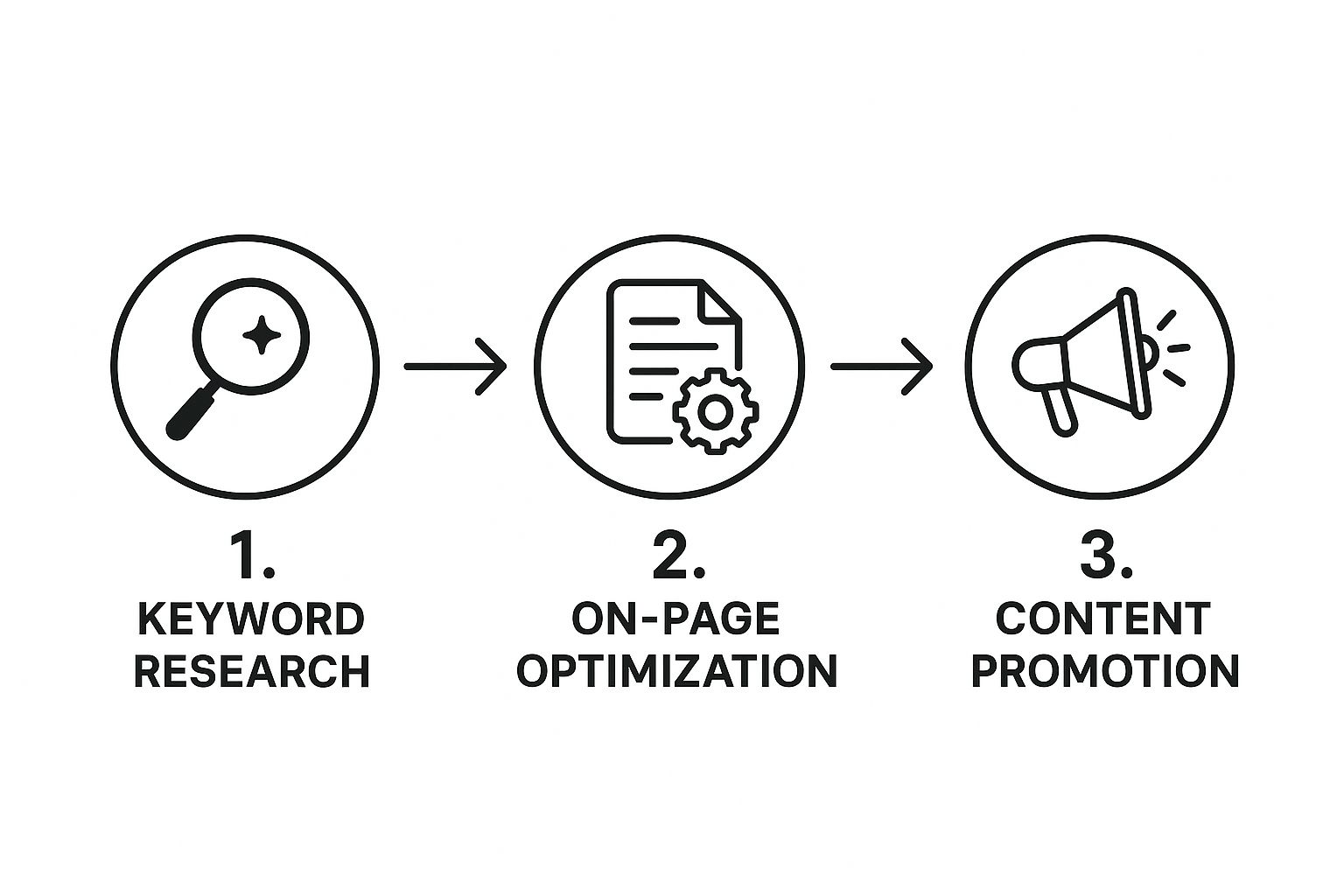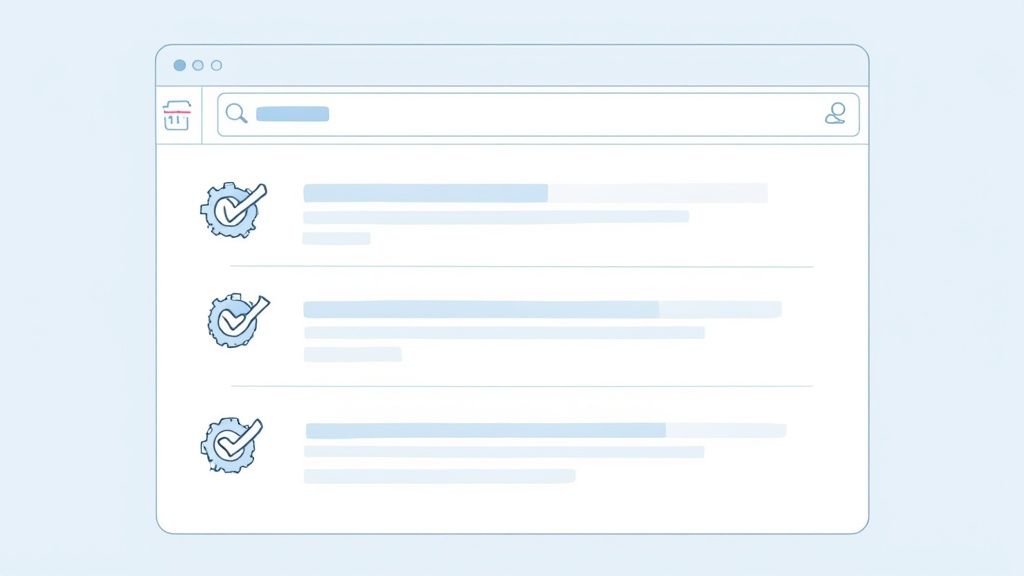How to Increase Website Traffic That Actually Converts

Getting more traffic to your website isn't about finding some secret hack or a single magic bullet. I've learned it's about building a solid, multi-channel system—one that combines smart SEO, content people actually want to read, savvy distribution, and a rock-solid technical foundation. This whole approach is a shift away from chasing vanity metrics and toward attracting visitors who are genuinely interested in what you have to offer.
Your Blueprint For Sustainable Traffic Growth
The real goal here is to create a reliable engine for growth. Instead of desperately chasing those fleeting traffic spikes that die out as quickly as they appear, a well-rounded strategy brings in a steady stream of qualified visitors day in and day out. This means moving beyond generic advice and putting a real-world blueprint into action. There are tons of proven strategies to increase website traffic that show how this mix of smart content, technical work, and promotion really comes together.
Consistency is everything. The good news is that foundational strategies are proving more resilient than ever, even with all the major search engine algorithm updates we've seen lately. Recent data shows 43% of web analysts reported an increase in traffic for their main website, while only 14% saw a decrease. That stability tells me that getting the fundamentals right is what truly pays off in the long run.
The Core Traffic Generation Process
Building this system follows a pretty logical flow. It all starts with really understanding your audience and ends with getting your valuable content in front of them. It’s a cycle, really, because the insights you get from promotion feed right back into your next round of keyword research and content ideas.
This simple infographic breaks down the fundamental workflow perfectly. It’s all about the interplay between keyword research, on-page optimization, and content promotion.

What I love about this visual is that it underscores that traffic growth is a systematic process, not just a random collection of tactics. Each step builds on the last, creating a strategy that’s both cohesive and effective.
If you're just starting out, getting a handle on these interconnected pillars is the absolute best first step. You can check out our guide on digital marketing 101 for a deeper dive into these foundational concepts.
Key Website Traffic Growth Strategies at a Glance
To make this even clearer, I've put together a quick table that summarizes the core strategies we're talking about. Think of this as your cheat sheet for building a traffic-driving machine.
| Strategy Area | Primary Goal | Example Key Actions |
|---|---|---|
| SEO | Improve organic visibility on search engines. | Keyword research, on-page optimization, link building. |
| Content Marketing | Attract and engage a target audience. | Blog posts, case studies, video creation, whitepapers. |
| Social Media | Build a community and drive referral traffic. | Posting valuable content, engaging with followers, running targeted ads. |
| Technical SEO | Ensure search engines can crawl and index your site. | Improving site speed, fixing broken links, implementing schema markup. |
Each of these areas is a critical piece of the puzzle. When they all work together, you create a powerful, sustainable system for bringing the right people to your website.
Capture High-Intent Visitors with Modern SEO
Let's be real: old-school SEO is dead. Gone are the days of stuffing keywords into pages and hoping for the best. Winning at search today means getting inside your audience's head, figuring out exactly what they’re looking for, and then delivering it. That’s how you attract visitors who are actually ready to engage, not just bounce.
It all starts with a simple shift in how you think. Instead of asking, "what keywords can I rank for?" you need to be asking, "what problems are my customers trying to solve?" This one change is the secret sauce behind any modern, effective SEO strategy.

Uncover User Intent with Smarter Keyword Research
Your goal is to dig for long-tail keywords. These are the longer, super-specific phrases people type into Google when they know what they want. Think less "marketing software" and more "best social media scheduler for small business."
Sure, the search volume is lower. But the intent? It's sky-high. Someone searching for that phrase isn't just window shopping; they have a problem and are actively looking for a product to solve it. Nailing these keywords is how you drive website traffic that converts.
The most effective SEO strategy is to have a marketing plan for every single piece of content you create. You should know exactly who the audience is and how you will get your content in front of them before you even start writing.
This isn't just about search rankings; it's about building a recognized brand. While organic search drives a hefty 29% of website traffic, don't forget that direct channels still dominate, bringing in 58% of all visits globally. That tells you that having a strong brand people remember and seek out is just as crucial. You can dig deeper into website traffic statistics to see the full picture.
Optimize Your On-Page Elements
Once you've found your golden keywords, it's time to put them to work. On-page SEO is all about signaling to both readers and search engines what your content is about, without sounding like a robot.
Here's a quick rundown of the essentials:
- Title Tags: This is your headline in the search results. It has one job: make people click. It needs to be catchy and include your main keyword right up front.
- Meta Descriptions: Think of this as your 160-character ad. While it doesn't directly impact rankings, a killer meta description can be the difference between someone clicking your link or your competitor's.
- Headings (H1, H2, H3): Headings give your content structure. They make your articles easy to scan for busy readers and help search engines understand the key topics you're covering.
- URL Slugs: Keep your URLs clean and descriptive. A URL like
yourdomain.com/increase-website-trafficis far more effective (and user-friendly) than a jumbled mess of numbers and characters.
Create Content People Actually Want to Read
Let's be honest, great content is the engine behind any strategy to get more eyes on your website. If you really want to boost your traffic, you have to stop churning out generic blog posts. The goal is to create assets that pull people in, answer their questions better than anyone else, and cement you as an authority.
This all comes down to mastering user intent—getting inside your reader's head and understanding the real question they're asking with every search.
When someone types "how to increase website traffic" into Google, they aren't just looking for a random list. They're searching for proven, actionable methods they can apply to their own business. Your job is to create the single best resource on the web that completely satisfies that need.

Go Beyond Standard Blog Posts
Blogs are a cornerstone, no doubt. But if you really want to connect with different parts of your audience and build authority faster, you need to mix things up.
Think about creating a diverse content library that serves various needs:
- Comprehensive Guides: These are the long-form monsters that become the definitive resource in your niche. They attract backlinks naturally and bring in steady traffic for years.
- Original Data Studies: Got some unique data or survey results? Publish them. This is one of the most powerful ways to get cited by other websites, which drives incredibly valuable referral traffic your way.
- Problem-Solving Videos: For some topics, a quick two-minute video that solves a common pain point is way more effective than a 2,000-word article.
The most impactful content has a clear marketing plan behind it before a single word is written. You should know who your audience is and how you'll get the content in front of them. Hope is not a strategy.
Structure Your Content for Authority
A tried-and-true framework for signaling your expertise to search engines is the topic cluster model. It sounds technical, but the concept is simple. You create one massive "pillar page" on a broad topic, then link out from it to several "cluster pages" that dive deep into specific subtopics.
Imagine a SaaS company creating a pillar guide on 'Project Management for Small Teams.' They could then support it with cluster articles on specific angles like 'Choosing the Right PM Software' or 'Running Effective Team Meetings.'
This structure does more than just organize your content logically. It shows search engines that you have deep expertise on the subject, which can boost your rankings for a whole range of related keywords. To dive deeper, check out these excellent content marketing best practices.
Of course, to make sure your content really performs, you'll want to explore some comprehensive SEO content optimization strategies.
Find Your Audience on Social and Community Platforms
Just blasting your content across every social media channel you can think of is a classic recipe for low engagement and a whole lot of wasted time. A much smarter way to drive real traffic to your website is to go where your ideal audience already hangs out online.
This means you need to shift your mindset from pure promotion to genuine contribution.
Instead of just dropping links and running, your goal should be to spark actual conversations. When you share a new blog post, try posing a question. For example, instead of a flat "New Post: 10 SEO Tips," try something like, "We just broke down 10 SEO tips for 2024. What’s the one tip that has made the biggest difference for your website traffic?" This tiny change invites people to chime in, making your content way more visible. Building a solid plan around this is crucial, and you can dive deeper into creating an effective content strategy for social media with our detailed guide.
Tapping into Niche Communities
The real, often-missed opportunity for traffic lies beyond the usual suspects like Facebook and Twitter. Niche communities on platforms like Reddit, Quora, or industry-specific forums are absolute goldmines. These are places where people are actively looking for answers to very specific problems.
The most powerful way to drive traffic from these communities is to become a trusted resource, not a marketer. Spend 90% of your time providing real value and only 10% mentioning your own content where it’s genuinely helpful.
Think about it like this: a software company could start monitoring a subreddit related to their industry. By consistently jumping in to provide detailed, helpful answers to user questions, they slowly build up credibility. Then, when it’s truly relevant, they can naturally link to a comprehensive guide on their own site.
This isn't a quick hack. It’s about playing the long game by earning trust first. That trust is what fuels sustainable website traffic and establishes an authority that paid ads just can't buy.
Build a Technical Foundation That Search Engines Love
You could write the most compelling content on the planet, but if your website is slow, clunky, or just plain broken on mobile, you’re losing visitors before they even get a chance to read it. A strong technical foundation isn’t just some "nice-to-have" item on a checklist; it’s the engine that powers every other traffic-driving effort you make.
Without it, even your best articles might never get discovered. Think of it like this: you can't get customers in the door if the entrance to your store is blocked.

Prioritize a Flawless Mobile Experience
In this day and age, starting with a mobile-first design is completely non-negotiable. With mobile devices now driving nearly 60% of global website traffic, how your site looks and feels on a smartphone is frankly more important than how it performs on a desktop.
This isn't just about aesthetics; it's about pure usability and keeping people on your site. A bad mobile experience is a direct path to lost traffic. In fact, 68% of users are five times more likely to leave a site if it isn’t optimized for their phone. If you need more convincing, you can explore more mobile traffic statistics to see just how critical this is.
A genuinely mobile-friendly site means:
- Text is readable without pinching to zoom.
- Buttons and links are big enough to tap easily with a thumb.
- The layout snaps perfectly into place on any screen size.
Make Your Website Blazing Fast
Page speed is a massive deal-breaker for both your visitors and for search engines like Google. A slow-loading site doesn't just frustrate people—it's a known ranking factor that can hold your content back. We all expect instant results, and even a tiny one-second delay can send your bounce rate through the roof.
Your goal should be to create a user experience so seamless that visitors forget they are navigating a website. Speed is a massive part of that invisible, high-quality experience that keeps people coming back.
Want to boost your site's speed? Focus on these quick wins first:
- Compress Your Images: This is often the biggest and easiest fix. Use tools to shrink image file sizes without sacrificing much quality.
- Enable Browser Caching: This lets a visitor's browser "remember" parts of your site, so it loads way faster on their second visit.
- Minimize Code: Clean up unnecessary CSS and JavaScript that can slow down how quickly your site appears on screen.
When you build a fast, mobile-friendly site with a logical structure, you create a solid foundation that helps both users and search engines fall in love with your content.
Your Top Questions About Driving More Traffic
So, How Long Does SEO Actually Take to Work?
This is the big question everyone asks, and the honest answer is: it’s a long-term game. SEO isn’t like flipping a switch; it’s more like planting a tree.
You might notice small bumps in traffic within a few weeks from some on-page optimizations, but the real, meaningful results from your content and link-building efforts usually take 4 to 12 months to kick in. A lot depends on how competitive your industry is and how consistently you're putting in the work. Patience is key here.
Should I Pay for Traffic or Stick to Free Methods?
Honestly, the smartest approach is a mix of both. Think of organic methods like SEO and content marketing as building a valuable asset for your business. It's the foundation that creates sustainable, long-term growth and keeps paying you back over time.
Paid traffic, like running ads, is your accelerator. It delivers immediate visitors and data, which is perfect when you need to test a new product, get a specific campaign off the ground, or just get quick feedback. Use paid ads to get that initial momentum while your organic engine is warming up.
The most effective approach is to have a marketing plan for every single piece of content. You should know exactly who the audience is and how you will get your content in front of them before you even start writing.
What’s the #1 Thing I Should Focus on for More Website Traffic?
If you can only do one thing, make it this: create high-quality content that obsessively solves your target audience's problems.
Everything else—from SEO and social media to link building—is just a way to get that valuable content in front of the right people. If the content itself isn't genuinely helpful, all those other marketing efforts will eventually fall flat. Your content is the true engine of your traffic growth.
Turn your expert content into engaging visual carousels that stand out online. Lumeo uses AI to help you create stunning presentations from articles, videos, and more, making it simple to capture attention and grow your audience. Start creating for free at https://lumeo.me.